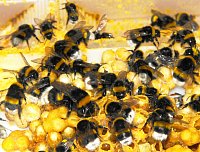Bombus terrestris and its parasite Crithidia bombi.
Population genetic analysis and experimental evolution of virulence
Host-parasite interactions may be influenced by processes that follow the dynamics of the Red Queen hypothesis due to a cycling of virulence and resistance factors in the parasite and host, respectively. The evolution of virulence factors might be driven either by between-host selection or by within-host selection. However, the relative contribution of both factors to virulence evolution has not been tested empirically. Using the bumblebee (Bombus terrestris) and their intestinal parasite Crithidia bombi (Trypanosomatidae) we will test hypotheses for the evolution of virulence factors as well as unravel their molecular basis.

The Bombus-Crithidia system is well established in the field of evolutionary ecology. Besides, there are useful molecular tools available that will enhance the molecular dissection of this host-parasite system. We will study natural populations to reveal the population structure of host and parasite in different populations. Isolates from these populations will be used to determine the naturally occurring levels of virulence in relation to the host population structure. These data will define the parameter space that is tested empirically in an experimental evolution approach. We will conduct serial passage experiments to study the evolution of virulence depending on different factors of the host population structure (between-host selection). Furthermore, we will study within-host selection by a multiple infection approach.
